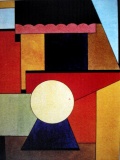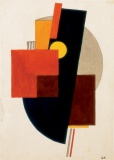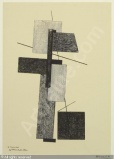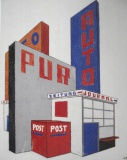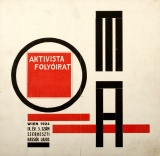Lajos Kassák
Jump to navigation
Jump to search
 Kassák in Vienna, c1922. | |
| Born |
March 21, 1887 Érsekújvár, Austria-Hungary (now Nové Zámky, Slovakia) |
|---|---|
| Died |
July 22, 1967 (aged 80) Budapest, Hungary |
| Web | Wikipedia |
| Collections | MoMA |
Lajos Kassák (1887–1967) was a Hungarian poet, novelist, painter, essayist, editor, and theoretician of the avant-garde.
Chronology
Based on the panel at permanent exhibition in the Kassák Museum, Budapest; there compiled from biographical text by Ferenc Csaplár.
- 1887: Born in Érsekújvár, Austria-Hungary.
- 1900: Leaves school for apprenticeship as locksmith.
- 1904: Moves to Budapest and starts working in factories in Angyalföld and Újpest. Participates in trades union political campaigns and joins Hungarian Social Democratic Party.
- 1908: First poem published in the weekly Újpest.
- 1909: Sets out for Western Europe on foot, with no money. Discovers art in the museums. Returns to Budapest in December.
- 1915: Founds anti-militarist periodical A Tett [The Action].
- 1916: The international issue of A Tett appears with contributions from writers and artists from countries at war with the monarchy, and the periodical is banned. Launches a new periodical MA [Today].
- 1919: During Hungarian Soviet Republic enters into dispute with Commissar Bela Kun over avant-garde art and the independence of art from politics. MA subsequently prevented from appearing. After the failure of the Soviet Republic spends five months in prison.
- 1920: After his release, leaves the country for exile in Vienna. Relaunches MA, formulates the theoretical basis of Hungarian constructivism and develops wide contacts with European avant-garde movements.
- 1926: Returns to Hungary and starts up new journal, Dokumentum [Document] which lasts for one year.
- 1928: Launches a new, independent, left-wing journal Munka [Work] and associated movement.
- 1928-34: Leader of a socially-aware educational society of students and workers, grouped around Munka. Writes regularly for the newspapers Népszava [People's Voice] and Szocializmus [Socialism], protesting against Stalinist tyranny and extreme right-wing movements.
- 1939: Exhibits in the Galerie Charpentier, Paris. A new law restricting press freedom closes down Munka.
- 1940-45: Publishes several novels, books of reports and books of verse. In 1940, an anti-war poem causes him to be imprisoned for two months under a 1937 court judgement.
- 1945: After the war takes on several positions in cultural affairs in the new political climate. Edits the relaunched Új Idők [New Times] and then the Alkotás [Art] and Kortárs [The Contemporary].
- 1948: His journals are closed down, he is excluded from public affairs, and his poems and articles cannot be published.
- 1956: Stands up for the Revolution, returns to artistic affairs.
- 1957: Public involvement limited, but his old writing begins to be republished.
- 1960: Exhibition of his work in the Galerie Denise René in Paris, resumption of his international career. Still ignored as an artist in Hungary.
- 1965: Awarded Kossuth Prize for his poetry.
- 1967: Holds the last exhibition in his life in the Adolf Fényes Room in Budapest, at his own expense.
Works
Képarchitektúra [Picture Architecture], 1922. Gouache on paper. 26 x 20 cm. [1]
Portraits
Publications
- Magazines
- editor, A Tett, 17 numbers, 1915-16.
- editor, MA, 76 numbers, Budapest (1916-19) and Vienna (1919-25), 1916-25.
- editor, Akasztott Ember, 5 numbers, Vienna, 1922-23.
- editor, Dokumentum, 5 numbers, Budapest, 1926-27.
- editor, Munka, 65 numbers, Budapest, 1928-39.
- Books
- Novellaskonyv: Válogatott novellák 1911-1919, Vienna: Bán-Verlag, 1921, 123 pp. (Hungarian)
- editor, with Lászlo Moholy-Nagy, Buch neuer Künstler, Vienna and Budapest: Aktivista Foliorat, 1922. An anthology of modern art and poetry. [2] (German)
- Új művészek könyve, Bécs, 1922; repr., Budapest: Európa-Corvina, 1977, 104 pp. [3] (Hungarian)
- MA Buch. Gedichte, trans. & intro. Andreas Gáspár, Berlin: Der Sturm, 1923; facs., Budapest: Kassák Múzeum, 1999. (German)
- Kôň zomrie, vtáky sa rozletia, trans. Vojtěch Kondrót, Bratislava: Slovenský spisovateľ, 1971. Poems. (Slovak)
- more
Catalogues
- Kassák, eds. Ferenc Csaplár, Mariann Gergely, Péter György, and Gábor Pataki, Budapest: Magyar Nemzeti Galéria & Petőfi Irodalmi Múzeum, 1987. (Hungarian)
- Szász János, Kovács Tamás, Lappangó elem, Budapest: Kassák Museum, 1991. (Hungarian)
- Kassák Lajos: Érsekújvár, ed. Ferenc Csaplár, Budapest: Kassák Múzeum, 1992. (Hungarian)
- Kassák Lajos: Reklám és modern tipográfia, ed. Ferenc Csaplár, Budapest: Kassák Múzeum, 1999. (Hungarian)
- Lajos Kassák: Reklame und moderne Typografie, ed. Ferenc Csaplár, Budapest: Kassák Museum, 1999. (German)
- Lajos Kassák: The Advertisement and Modern Typography, ed. Csaplár Ferenc, Budapest: Kassák Múzeum, 1999. (English)
- Lajos Kassák. Botschafter der Avantgarde 1915-1927, Budapest: Literaturmuseum Petőfi & Kassák Museum, 2011, 101 pp. [4] (German)
- Jelzés a világba – Háború ∩ avantgárd ∩ Kassák, eds. Gábor Dobó and Merse Pál Szeredi, Budapest: Kassák Alapítvány, 2016. TOC. [5] (Hungarian)
- Signal to the World: War ∩ Avant-Garde ∩ Kassák, eds. Gábor Dobó and Merse Pál Szeredi, Budapest: Kassák Foundation, 2016. [6] (English)
Literature
- Endre Gáspár, Kassák Lajos - az ember és munkája, Bécs, 1924. (Hungarian)
- Tomáš Štrauss, Kassák. Ein ungarischer Beitrag zum Konstruktivizmus, Cologne, 1975. (German)
- Emőke G. Komoróczy, Kassák és a magyar avantgárd mozgalom, 1995, 137 pp. (Hungarian)
- Marian Mazzone, "Dadaist Text / Constructivist Image: Kassák's Képarchitektúra", Hungarian Studies Review 31:1-2 (2004). (English)
- Zoltán Péter, Lajos Kassák, Wien und der Konstruktivismus 1920-1926, Frankfurt am Main: Peter Lang, 2010, 316 pp. [7]. Review: Deréky (Kakanien 2010). (German)
- ...fejünkből töröljük ki a regulákat" Kassák Lajos az író, képzőművész, szerkesztő és közszereplő, ed. Andrási Gábor, Budapest: Petőfi Irodalmi Múzeum & Kassák Alapítvány, 2010. (Hungarian)
See also
Links
- The Kassák Museum and the Kassák Foundation, Budapest.
- Biography on the website of the Kassák Museum.
- http://musessquare.blogspot.com/2011/03/kassak-lajos.html
- http://www.hunlit.hu/kassaklajos,en
- http://www.artpool.hu/Kassak/Kassak_quotationshu.html
- http://www.artpool.hu/Poetry/soundimage/Kassak.html
- http://www.artnet.com/artists/lajos-kassák/past-auction-results

